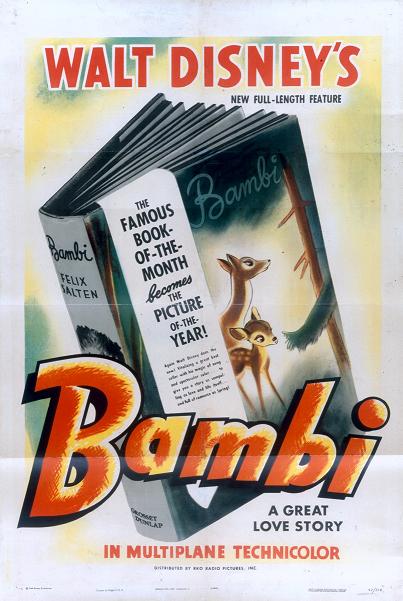Walt Disney’s Bambi is screening every day in June at 1 & 4pm (except Tuesdays, and June 11 & 25) in the state-of-the-art digital theatre at The Walt Disney Family Museum. Tickets are available at the Reception and Member Service Desk at our museum, or online at www.waltdisney.org.
 Bambi was a problem child.
Bambi was a problem child.
Based on a revered novel, the dignified and philosophical story cried out for a different kind of filmmaking, both in content and visual realization.
“Walt couldn’t get a hold of Bambi,” animator Frank Thomas recalled. “He didn’t know what he was supposed to do with it.”
In addition to challenges with adapting the novel’s naturalistic and thoughtful plot was the fact that all of the characters were animals. “It was a difficult picture because we’d never done any character with anatomy, any animal with anatomy, and Walt wanted the deer to be very believable,” animator Ollie Johnston recalled. “He wanted the deer to have personality, but be believable. Not realistic, butbelievable.”
The act of caricature was critical. Thomas adds, “[Walt] said, ‘Gee, if you want it to be real deer, why don’t you photograph some real deer and do it that way. You don’t mess around with drawing.’”
“We were trying to do something that had not been done before,” animator Marc Davis said, “which was to do animals that were caricatures but at the same time moved realistically.”
The difficulties caused delay after delay. “It was the second [animated feature] to do, on his schedule,” Thomas said. “Snow White was first, Bambi was second, and he didn’t know how to make Bambi, didn’t know what to do with the subject matter. So he moved it back on schedule and put Pinocchio ahead. Then he moved Pinocchio back and did Fantasia instead.”
“Well, actually it was a change of pace for us from what we’d been doing,” Walt said. “Snow White, Pinocchio, and the others were more the obvious cartoon-type of characters. But with Bambi there was a need for subtlety in our animation, and a need for more of a life-like type of animation. There was a certain awe and respect we had of this classic of Bambi that I decided that, well, number one, I’d have to put my artists back in school.
“Now you know, animal anatomy is a thing that very few artists ever get anyway. And before I started Bambi we had been doing these little cartoon animals. But Bambi, they had to be a little closer to the real animal—it’s a caricature with a certain little humanized touch, but still believable as deer as animals in the forest. So the background for that was a good study of animal anatomy, and how deer and how these other animals actually moved, reacted.
“So I set up this special training course before I started Bambi, and I selected the artists that were going to work on Bambi, and we put in an intensive series of training on animal anatomy. I brought in the best instructor on animal anatomy, name of Rico Lebrun. Rico was teaching around—he was in Santa Barbara then when I brought him down for a six-week course.”

Lebrun did not limit training to academics, either. As the study progressed, live models were brought in. Walt said, “I had animals at the studio. I had deer and raccoon. I had everything. You see we had quite a small zoo there. And we had them in class, well that wasn’t good enough because animals in a cage or in captivity don’t respond naturally.
“So I got a couple…freelance cameramen, with 16mm film, and I sent them out. I sent them into the woods and had them photograph deer, and I got quite a bit of natural animal action, and we bought that in to study. The little quick movements of the squirrel. They stop, listen, move fast, everything, same as a deer, you know? The way they wag their tail and everything like that.”
The difficulty of the endeavor and the investment of time, talent, and care to the process led to the creation of a milestone in the art and craft of animation performance. Animator Milt Kahl said, “In appearance, physical appearance, we came as close to as we figured we possibly could to the real deer and still be able to articulate the dialogue and still have a full range of expression.”
In the end, Walt felt that the effort was well rewarded. He said, “Bambi was one that we had a little trouble starting…when we finally got our own little plan for Bambi, why we began to roll; we had a lot of fun with it.”
This month, The Walt Disney Family Museum celebrates Walt Disney’s brilliant and timeless 1942 animated feature, Bambi. On Saturday, June 25 at 3pm, author and historian J.B. Kaufman will offer an entertaining insight into the visual style and creative evolution of Bambi in his presentation The Anatomy of an Animal: Animating a Deer.
Join us for a Live Study Sketch Session on Saturday June 25 from 10am - noon on the Museum Front Lawn. We're bringing in live animal models, and offering you the opportunity to observe and sketch them, just as the Disney artist do. Don't miss this opportunity to join an artist on our front lawn, and bring the inspiration of live animal models to your own illustrations. (This activity is weather permitting.)
